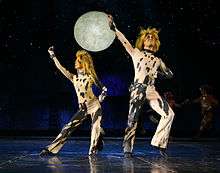Mungojerrie and Rumpleteazer

Mungojerrie and Rumpleteazer[1] are fictional characters in T. S. Eliot's book, Old Possum's Book of Practical Cats, which was adapted into the musical Cats.
Characteristics
Mungojerrie and his partner in crime, Rumpleteazer, specialize in petty theft and mischief. In Eliot's original poem "Mungojerrie and Rumpelteazer", they are depicted knocking over Ming vases and stealing items from their human family. Mungojerrie is also mentioned in the poem "Macavity, the Mystery Cat", where he is rumoured to be one of Macavity's agents. They live at Victoria Grove in Kensington, England.
In Eliot's original poem, Rumpelteazer is suggested to be a male cat: "...they were plausible fellows..."[2] However, Rumpleteazer is usually portrayed as female in the musical.
In the original Broadway production, the person cast as Rumpleteazer doubled as another character, Etcetera. In smaller local productions, this double character casting still occurs. In addition, Rumpleteazer and Mungojerrie can be cast to double as another tertiary set of characters: the twins Tantomile and Coricopat.
The music
Three distinct versions of the "Mungojerrie and Rumpleteazer" music exist: the original London production's version has a slower tempo and more jazz-like sound, while the more common original Broadway version is upbeat.[3]
Andrew Lloyd Webber wrote a new setting of the song "Mungojerrie and Rumpleteazer" for the original Broadway production, in which the song was sung by Mr. Mistoffelees, while the actors playing Coricopat (Rene Clemente) and Etcetera (Christine Langner) danced the song as "dolls" made of junk, brought to life, and appearing out of the boot (trunk) of a car through the magic of Mr. Mistoffelees. In 1987, the Broadway production was re-worked and the song was given back to the characters of Mungojerrie and Rumpelteazer, then played by Ray Roderick (who had formerly been the character Carbuckety) and Christine Langner, whose role of Etcetera was replaced by Rumpleteazer. They pretend to be dogs in one song, "The Awefull Battle of the Pekes and the Pollicles".
Descriptions and costumes
Onstage, Mungojerrie and Rumpleteazer are usually costumed as orange, black and brown calico or tabby cats. Their relation, be it siblings, friends or mates, is unknown. In the original Broadway production, they wore baggy clown-like costumes seemingly made of various food wrappers as characters performing for Bustopher Jones. Generally, Mungojerrie's costume is a darker, more heavily striped tabby pattern, while Rumpleteazer is paler. However, when they perform their duet song, they have additional costume pieces that vary by which version of the song is performed: a vest and stockings for Mungojerrie and a leotard and stockings for the original Rumpleteazer, or pearls for the modern Rumpleteazer. This has the effect of making them appear almost identically marked.
Original players
Mungojerrie
Mungojerrie was portrayed by Drew Varley in the 1998 CATS Film, and John Thornton in the original London cast, and is now played by Daniel Switzer in the North American Tour. In the original Broadway production he was played by Rene Clemente, who also played Coricopat.
Rumpleteazer
Rumpleteazer was portrayed by Christine Langner in the original Broadway cast; Bonnie Langford in the original London cast, and later Jo Gibb in both London and in the filmed video version.
Cultural references
- The skiffle band Mungo Jerry, most famous for their hit "In the Summertime", are named after the character.[4]
References
- ↑ Note: in Eliot's original work, the name is spelled "Rumpelteazer".
- ↑ Page 22, Old Possum's Book of Practical Cats, London 1984
- ↑ Note: The version of the show as licensed by the Rodgers and Hammerstein Theatre Library is at first similar to the Broadway version, but then changes the 7/8 time signature to 4/4 time.
- ↑ Rice, Jo (1982). The Guinness Book of 500 Number One Hits (1st ed.). Enfield, Middlesex: Guinness Superlatives Ltd. p. 133. ISBN 0-85112-250-7.
External links
- "It's That Horrible Cat: A Mungojerrie Tribute" at the Wayback Machine (archived November 21, 2008)